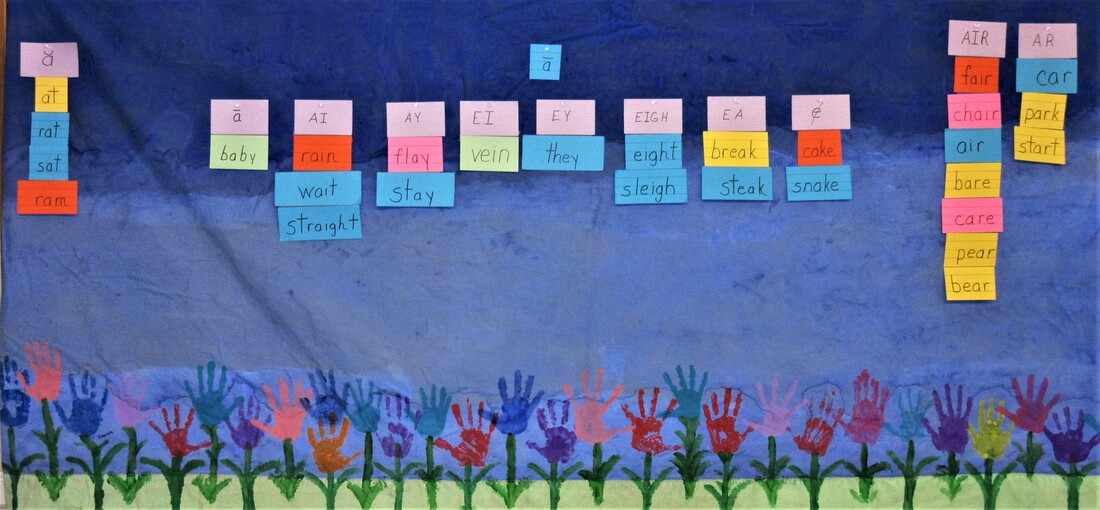 With vowel clustering, children learn to break words down into letter sounds or sound clusters. No rules or word lists to memorize.
With vowel clustering, children learn to break words down into letter sounds or sound clusters. No rules or word lists to memorize. Everyone is still talking about the learning losses caused by COVID. The big question is are we making any progress toward correcting these learning losses?
The answer is unclear. Several states are reporting problems:
- The North Carolina Department of Public Instruction, Learning Recovery and Acceleration (OLR) reported that “learning progress slowed across all grades and subjects.” The OLR also stated on the average, students made less progress last year than in previous years.
- Superintendent Kevin Whitaker from Jamestown Public Schools (JPS) in New York state also confirms concern over learning losses during the pandemic. He explained that JPS would be working on overcoming these learning losses through Academic Intervention Services (AIS). As Superintendent Whitaker stated,
“We are focused on learning loss recovery…. There’s been a tremendous amount of loss over the course of the past two years, and we’re hoping to address that with AIS teachers and reading teachers and some additional teachers on staff. But the second big item would be mental health support. We are committed to addressing the mental health stresses, anxieties and other mental health issues that have arisen as a result of the pandemic.”
It is wise that the Jamestown Public Schools are looking at both the academic and mental health needs of their students. In my reading clinics, I combine both learning and counseling. It helps students learn and correct old learning problems.
While many state education officials talk about learning losses in the classroom from COVID, I could not find anyone reporting on improvement. In fact, how will we know if learning losses are being corrected?
The only true way to measure improvement is through testing. Although some states are reporting test data, most are not.
One Example: The Texas Education Agency Report
As stated earlier, it’s hard to measure the exact extent of learning losses from the pandemic. Accurate test data is difficult to obtain unless states compare today’s test data with the test results obtained before the pandemic. You cannot compare apples and oranges. In order to accurately measure learning loss, you must use the same test.
Fortunately, the Texas Education Agency did release comparative test data and stated,
“Since 2012, test results in the state had been steadily improving, but after COVID-19 related disruptions, the percentage of students meeting reading expectations dropped back to 2016 rates and the percentage meeting math expectations dropped to 2013 passing rates. Math test performance saw the most significant drop, from 50% of students meeting their grade level in 2019 to only 35% this year.”
This is from the 2021 report. The 2022 scores are not available yet. The report shows what most of us would expect from 2021—no improvement.
Were Learning Losses Worse Before or After COVID?
The Texas Education Agency report shows that 50% were reading below grade level before COVID. The report talks extensively about how well scores were rising before COVID, but if you look carefully at the test scores presented in this report, the learning losses before COVID are much greater than the losses caused by COVID.
This is not a new problem, and it is not just happening in Texas. It is a nationwide problem. As a nation, we had devastating learning losses in reading before COVID. According to the Nation’s Report Card, over 60% of students could not read at grade level before the pandemic.
___________
For more on the learning losses that existed in reading before COVID, see: Reading Wars are Over! Phonics Failed. Whole Language Failed. Balanced Literacy Failed. Who Won? It Certainly Wasn’t the Students
___________
Our original question was: Are schools making progress in reducing learning loss?
Thus far, we have not found any proof of improvement.
It seems that so far, everyone is still trying to discuss how much COVID affected students. Schools are talking about solutions, but we are not seeing any progress reports on that improvement.
Is There a Solution?
Texas Education Commissioner Mike Morath continued,
“… only 4% of students across all grades who are below grade level catch up within two years.”
Isn’t a 4% expected improvement rate completely and totally unacceptable?
At my reading clinic, I expect and produce such results as:
- A student who failed for nine straight years in public school is now reading.
- A student diagnosed with ADHD and failing in reading moved up two grade levels in one year.
- A student diagnosed with dyslexia and whose parents tried everything, including expensive private one-on-one systematic phonics tutoring, learned to read, and moved up to beginning chapter books in one year.
- Six children who entered the program reading at the (pre-K) level ended the year reading at the 2nd grade reading level. Only one child in the group was a first grader.
- One student started at the pre-K level and ended the year reading at the third-grade level, while a second grader started the year reading below first grade and ended at the fourth-grade level. This improvement was just from September to May.
- One year, a student moved up four grade levels in reading, 4 students moved up three grade levels in reading, and 8 students moved up two grade levels in reading after only 8 months of instruction.
- Another year, two students moved up four grade levels in reading, 3 students moved up 3 grade levels in reading, and 6 students moved up two grade levels in reading after only 8 months of instruction.
- Two students moved up 2 grade levels in reading after only 48 hours of instruction.
For the data on these students, see my book After-School Programming and Intrinsic Motivation
So, yes, we can teach failing students to read. If we use the correct teaching methods, we can correct all reading failure—before and after COVID. What method did I use? Vowel Clustering.
_______________
For more on Vowel Clustering, read: Vowel Clustering Works Better than Phonics with At-Risk Students
_______________
Will Tutoring Help?
The Texas Education report does say that Texas will be offering tutoring and special instruction to all students who do not pass the state test. Neither the new state law or the Texas Education Agency report explains if such tutoring will enable students to pass the state test and/or what steps will be taken for students who still do not pass the state test after tutoring.
We need to remember that most schools offer tutoring, even offered tutoring for students who were struggling before COVID. Tutoring is not new. Yet the Nation’s Report Card test scores were higher in reading in 2017 than they were in 2019. Yes, reading scores went down in 2019—before COVID.
The Nation’s Report Card showed that 4th grade students had a proficiently level (able to read at grade level) of 37% being able to read at grade level in 2017. They went down to 35% in 2019 who were able to read at grade level. This was before COVID.
In 8th grade the Nation’s Report Card showed similar results. Students went down from 36% proficient (able to read) to 34% proficient. Yes, that means that only 34% of 8th grade students were able to read at the 8th grade level. These scores are also before COVID.
Tutoring alone may not be enough to correct the learning losses that our students are facing.
We need to admit that we had a major educational problem in reading long before COVID. Because if we had been using the correct teaching methods in the classroom between 2017 and 2019, there is absolutely no reason that scores should have gone down. Unfortunately, scores will continue to go down until we change the way (teaching method) we teach children to read. We can blame it on COVID, but the real problem is not COVID learning losses. The real problem is how we teach children to read in the public school classroom.
I will say it again. Yes, we can teach children to read. If we use the correct teaching methods, we can correct all learning losses in reading. Unfortunately, we are not using the correct teaching methods in the classroom. No, I did not say it was the fault of teachers. Most teachers do not choose their own teaching methods. It’s also not poverty. Many of the students who I listed above from my reading clinic lived in the housing projects and were failing in reading when they entered my reading clinic.
School boards, politicians, and angry mobs choose the teaching methods in most school districts. Education in today’s public schools has nothing to do with teaching. Schools have become political pawns.
____________
For more on teaching methods presently being used in the classroom, see: When Phonics Fails
____________
Are the Schools Using the Best Solutions?
I think that it is vital to correct any and all learning losses caused by COVID, but just returning to the 2019 reading level is not acceptable. Continuing to use the same old teaching method is also not going to work. We cannot just ignore the learning losses that existed before COVID.
I have talked about this problem before. Most schools want to talk about the educational devastation caused by COVID, but they rarely mention the learning losses that existed before COVID.
Paul Reville, former Secretary of Education for the state of Massachusetts, provides an excellent point to consider as we strive to correct learning losses in the classroom.
“Those of us in education know these problems have existed forever…. We need to redesign our systems of child development and education.”
“… in this situation, we don’t simply want to frantically struggle to restore the status quo because the status quo wasn’t operating at an effective level …. We should be asking: How do we make our school, education, and child-development systems more individually responsive to the needs of our students? Why not construct a system that meets children where they are and gives them what they need inside and outside of school in order to be successful? Let’s take this opportunity to end the “one size fits all” factory model of education.”
Reville is correct. If we are to help students improve, then we must correct all learning losses, not just the ones caused by COVID. This brings us back to the question: Are the schools using the best solutions to solve learning loss problems?
____________
For more on the methods schools are using to correct learning losses, read: What Are Schools Saying about Pandemic Learning Losses, and What Is Being Done to Help? (Part 2 of a Series)
____________
Did We Answer the Question?
We did not find any proof that schools have corrected the learning losses from COVID. We are still waiting to see proof of improvement. The primary suggestion that most schools discuss is tutoring.
Is Tutoring the Answer?
Many of the schools are talking about tutoring. Tutoring can be effective; it may also not be effective. Like every other teaching method, it depends on the tutoring methods being used. Can tutoring solve the learning loss that students are struggling with?
We will look at tutoring in more depth next time. We will examine different tutoring methods that schools apply. In future posts, we’ll also examine some research that shows which tutoring methods may be best for helping struggling students recover.


 RSS Feed
RSS Feed
